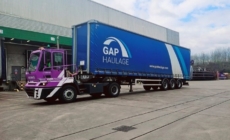-
Nutrivend selects Forterro’s Orderwise to support online expansion and streamline operations - April 11, 2025
-
ARROWXL LAUNCHES AMBITIOUS ZERO WASTE ROADMAP - April 8, 2025
-
THE BCMPA’S NEW CAMPAIGN DRIVES OUTSOURCING SUCCESS IN Q1 - April 7, 2025
-
BLACKOUT TECHNOLOGIES TARGETS TELEMATICS-INTEGRATED MOBILE DEVICE BLOCKING TO COMBAT SMARTPHONE DISTRACTION - April 1, 2025
-
OpenADR Alliance announces first OpenADR 3.0 certified products with EVoke Systems, E.ON Energy and Universal Devices - March 25, 2025
-
Growing fulfilment and contract packer appoints new Managing Director - March 25, 2025
-
When is it time to invest in a WMS? Understanding the key trigger points - March 25, 2025
-
eCapital helps Vantage Recruitment on its journey to financial success - March 24, 2025
-
Hugo Beck Celebrates 70 Years of Packaging Innovation with Open House Events - March 20, 2025
-
PROLOG FULFILMENT SUPPORTS LUNA DAILY’S COMMITMENT TO BETTER BODY CARE FOR ALL WOMEN - March 19, 2025
Can Blockchain reduce supply chain complexity and costs?
Blockchain—the technology behind the digital asset and payment system Bitcoin – is being mooted as the next big thing for supply chains. But how can this fledgling technology be used to benefit logistics and the greater supply chain? The answer lies in its potential to speed up administrative processes and to take costs out of the system while still guaranteeing the security of transactions, writes Gavin Parnell, Director of Go Supply Chain.
The underlying principle of blockchain is to provide a secure environment where encrypted business transactions between buyer and seller can happen without the need for third parties to intervene. This means that it could be a game-changer for supply chains.
Blockchain is essentially a trustworthy digital ledger that nobody can change, but anybody in a system can update. When they do, it is time-stamped and everybody in the system gets included in the update. Only one update can be made at a time, with each update to the ledger forming a ‘block’, and cumulative updates creating a chain of blocks – hence the term: ‘Blockchain’.
This distributed system operates over a network via the Internet. Individuals in the network keep copies of the blockchain on their personal computers and move the information, or a payment, on digitally by validating the transaction.
All the participants with a copy agree the state of the block chain at any given time. It is this consensus and the use of cryptography (storing and transmitting data in a particular form so that only those for whom it is intended can read and process it) that ensures records can’t be counterfeited or altered, giving Blockchain its high security.
An increasingly pertinent advantage of blockchain technology is to repel cyber attacks and forced outages. Hackers would not only need to hack into a specific block to alter existing information but would have to access all of the preceding blocks going back through the entire history of that blockchain, across every ledger in the network, simultaneously. And with no central organisation owning the system it is difficult to corrupt and everybody can use it and help run it.
What’s in it for Supply Chain?
The advantages of better data sharing across the supply chain would allow for:
• faster and more accurate tracking of products and distribution assets – for example containers, as they move through the supply chain
• a reduction of errors on orders, goods receipts, invoices and other trade related documents due to less need for manual reconciliation
• sharing of information about process improvements and maintenance in real-time
• a permanent audit trail of every product movement or financial transaction from its source to ultimate destination, reducing opportunities for fraud.
Accredited users in a specific supply chain would be able to access specific blocks of data in the system, either to view or transact. While still early days, take-up will accelerate as the possible applications become better understood.
Blockchain can be used to create ’smart’ contracts that execute the terms of any agreement when specified conditions are met. The “smart” part is a piece of computer code that predefines a set of rules under which the parties to that smart contract agree to interact with each other. The code facilitates, verifies, and enforces the performance of contract conditions.
In a retailer-supplier relationship, for example, it is possible to route purchase orders, invoices, receipts, shipping notifications, inventory data and other trade related documents to be automatically matched and verified. Payments and replenishment orders can be triggered automatically, based on the codified rules within a smart contract. There are obvious cost-saving opportunities in administratively heavy industries such as aviation and marine shipping.
Supply chain pioneers
Early adopters are pioneering supply chain blockchain applications in a number of industries. With the opening of the Walmart Food Safety Collaboration Center in Beijing, IBM, Walmart and Tsinghua University are collaborating to improve the way food is tracked, transported and sold to consumers across China. They are looking to harness blockchain technology to generate transparency and efficiency in supply chain record-keeping, with the aim of enhanced food safety for Chinese consumers.
With blockchain, food products can be digitally tracked from an ecosystem of suppliers to store shelves and ultimately to consumers. The information captured in each transaction is agreed upon by all members of the business network; once there is a consensus, it becomes a permanent record that can’t be altered. This helps assure that all information about the item is accurate.
The record created by the blockchain can also help retailers better manage the shelf-life of products in individual stores, and further strengthen safeguards related to food authenticity.
IBM, along with global transport and logistics company Maersk, is building a blockchain solution that will be made available to the shipping and logistics industry. The solution will help manage and track the paper trail of tens of millions of shipping containers across the world by digitising the supply chain process from end-to-end to enhance transparency and the highly secure sharing of information among trading partners. Maersk found in 2014 that just a simple shipment of refrigerated goods from East Africa to Europe can go through nearly 30 people and organisations, including more than 200 different interactions and communications among them. When adopted at scale, the blockchain solution has the potential to reduce complexity and save the industry billions of dollars.
In another logistics application ABN Amro, Delft University, the Port of Rotterdam and over a dozen other partners are joining forces to launch a large-scale project. Over the next two years, the partners in the TKI Dinalog project will be designing, developing, and implementing a new information infrastructure. This will be rooted in blockchain technology to connect operational information, financial flows and contracts.
It is early days and there are some challenges. There is a need to convince all involved parties to join a particular blockchain and collaborate for mutual benefit. Without this, it won’t work well. Business leaders will need to be open to sharing information with their tier 1 suppliers and others deeper in the supply chain. The old-age question ‘what’s in it for me?’ will need an answer before everyone is confident to share everything in these private ledgers.
Other hurdles are a lack of regulatory framework or standards, the cost of adapting legacy systems to blockchain, working out who pays for transaction process, and adopting a new mindset around a decentralised network with no central control.
These are all hurdles that can be addressed and blockchain remains a more powerful and broader concept than other bleeding edge technologies such as the Internet of Things. Ultimately, blockchain technology could help create more transparent and less vulnerable supply chains.
For further information visit www.gosupplychain.com

































